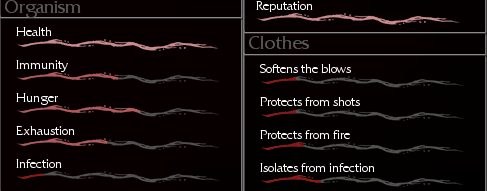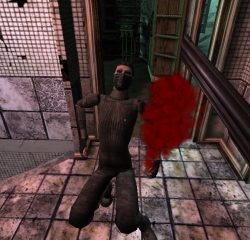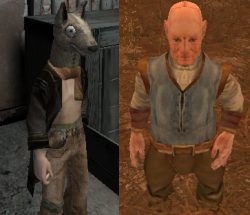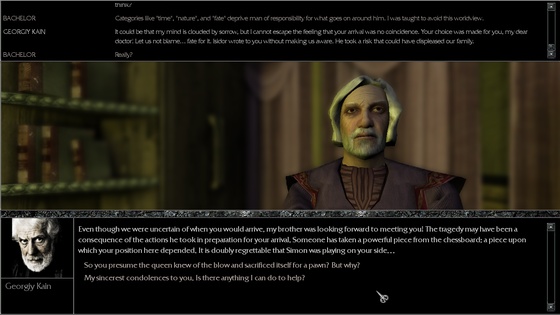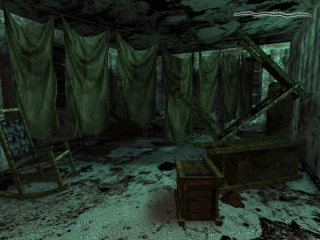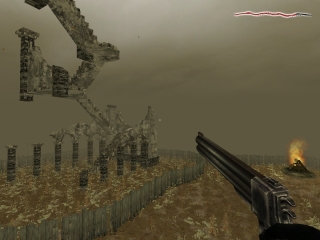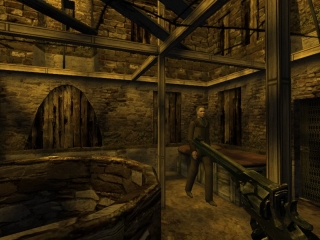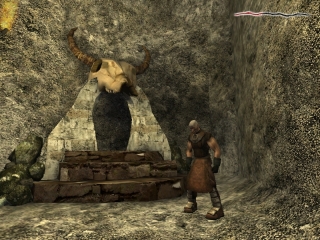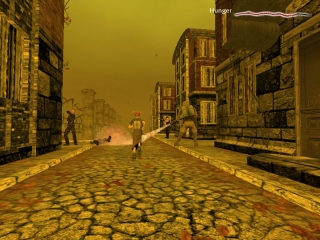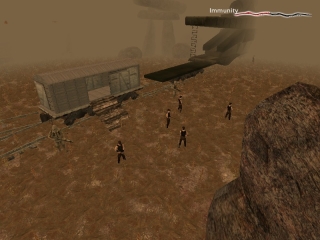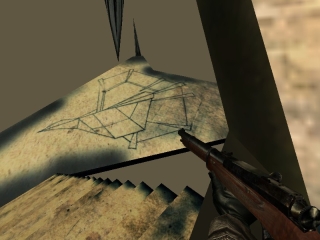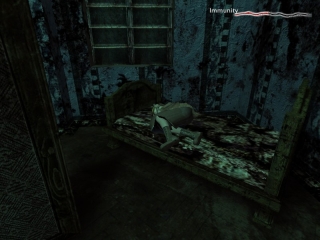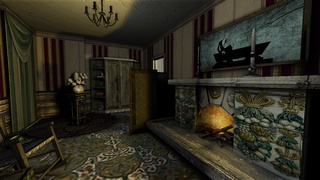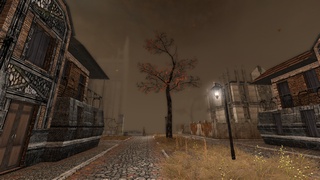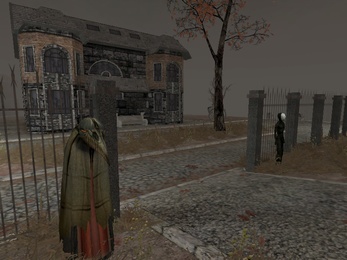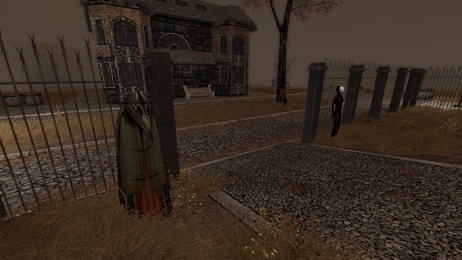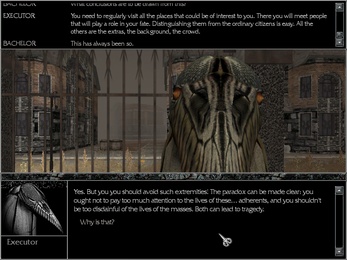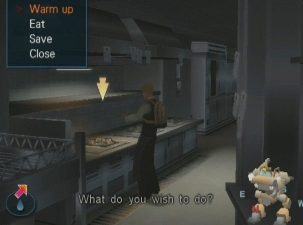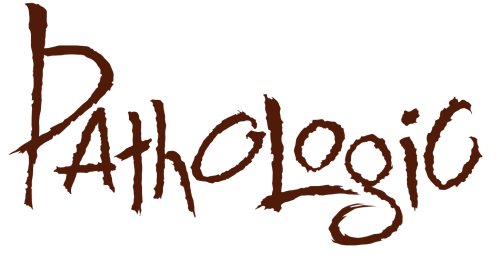
|
Next Page >>> |
|
Page 1: |
Page 2: |
|
|
|
Although it looks like an FPS, Pathologic is closer to a classic adventure game, with locations housing static characters that need interacting with to open up new avenues. Each of the 12 days has several secondary tasks, brought to the attention of the player via letters delivered throughout the day. Usually they involve visiting one of the above characters and performing a task, such as collecting medicine, delivering rifles, killing a group of enemies, or questioning someone. These can be ignored; secondary tasks usually but not always grant some nice rewards. Alongside these are also a single, primary task for that day, which tends to be more involved. As the bachelor for example, you might have to prove that a group of people aren't infected, visiting each in turn. As the Haruspicus it could be completing a test set by Elder Oyun, such as killing a trio of butchers while enduring increased hunger. Failure of a primary mission doesn't end the game, rather one of that player character's Adherents will get ill. Each of the main characters has a pre-assigned group of Adherents they need to keep alive until the end of the game, and failure to do so prevents you from accessing that person's main ending. If all your Adherents are alive you can enter the final and conclude things.
Here's where the ingenious part comes in though - and is the reason why the game isn't as difficult as most reviewers claim. Up until and during the 12th day, any Adherent which is ill (due to a failed mission), can be cured of the plague using a one of two rare items. During certain story missions players will be able to collect vials of panacea - and one-use cure all. There's about five available for both Daniel and Artemy, depending on how well you do. Alternatively, the very young girls which inhabit the town will have items for trade, including sometimes "children's powders", for which she'll want trinkets like pins, flowers, beads, nuts and so on. There's a whole sub-story to the creation of these powders, and while they damage the health quite severely, they do cure the plague and can be used on Adherents. It's quite possible to fail several primary tasks, and yet still have all your Adherents alive at the game's end. If you've played especially well, you can use your panacea and powders to save the Adherents of the other two characters, then invite them to the final location and choose their ending instead. This is a fantastic system, since an especially good player only needs complete the game once to see each of the character's unique endings. Whatever happens, always strive to acquire the children's powders. That way if you screw up, it's not a complete loss.
The endings deserve special mention, since there's another ingenious layer to things. Along with three endings (one for each character), and a general "failure" ending, there are two bonus endings: bonus ending A is acquired for saving all the Adherents of a second character in addition to your own, and ending B is accessible if you save every Adherent in the game. The B ending isn't that interesting given all the work it requires, but bonus ending A contains quite possibly the greatest, most mind-blowing twist in the history of videogame endings. It's not entirely original, similar themes have been used in books and films, but it's handled with tremendous subtlety here. Afterwards you realise there were several hints throughout the main game, and it also explains some otherwise unanswered questions. It is well worth working towards.
Can You Survive?
Overlaid on the adventure aspect, and masterfully intertwined with the narrative, is the previously mentioned survival system. The sad thing is, while the complexity of such a system used to be common place in PC gaming, today it's regarded as archaic and isn't seen so much (there are quite a few decent indie games though). A good comparison would be to Robinson's Requiem, while more recently the STALKER series features a similar style of bartering system, albeit with toned down survival mechanics. At its most basic, Pathologic requires you constantly administer enough survival items; it's a mixture of resource management and damage control, because as time progresses you are constantly "decaying". Hunger is easy enough to manage, since you just need to buy and eat food. Exhaustion is diminished through sleep, though be careful because your hunger goes up. If injured through fighting, you can top health up through medicines, which increase exhaustion, or tourniquets and bandages. One of the drugs you can get, Meradorm, is actually best administered before bedtime, since it causes health to increase while sleeping. You can drink coffee to stave off the sedative affects of the antibiotics, but this is bad for the health. Lemons will wake you up, but they increase hunger so you need more food. The best element though is when you become infected.
Getting infected is based on your immunity level - the higher the immunity, the less likely you are to catch the disease when walking through "plague clouds". You can increase your immunity through drugs, but these damage your health, so be careful. Once infected, the growth rate of the infection is suppressed by your immunity level, which dwindles as the infection increases. Once the infection reaches a certain level (maybe about 15%), you start to lose health, slowly at first but increasing with the infection rate. Things now require strategic planning. Curing the disease requires one of the two rare items best saved for Adherents, so instead you need to manage the disease. Before bed you should administer immunity boosters to slow the infection while sleeping, then take antibiotics to lower the infection level to minimum. Both of these will take massive hits on your health and increase exhaustion, so you then need to administer Meradorm to restore health while sleeping. A quick snack and it's time to sleep. You can medicate yourself during the day, but you're going to be feeling the effects as you run errands around town. It gets exciting though when the medicine runs out, the chemists are empty, you're low on money and supplies, and suddenly you're standing in the middle of town with nothing but a revolver and two bullets, and you're thinking to yourself: "I've got a fever, I desperately need to sleep but I can't, because I'll probably wake up dead if I don't get this damned infection under control!"
Although resources are extremely scarce, there are several methods for acquiring them. The simplest is bin raiding. Most contain empty bottles, which can be filled with water and traded with hungover drunks for bandages and tourniquets. These in turn can be bartered when shopping at merchants. Buns also contain broken pocket watches, beads, shaving razors, and discarded trinkets, like bangles and rings. All of these can be traded with the children wandering around town, who all seem to have gotten into their mother's medicine cabinet and father's weapon drawer. Basically worthless junk can be traded for drugs and ammo, which in turn can also be bartered. Some of this junk can also be bought from the barman at the tavern. As Daniel you can try looking for the twyrine herbs that grow all over the place, and then trade them with Andre at the tavern for ammo. Artemy has a unique ability, since as a hereditary menkhu he can dissect bodies and harvest organs - quite legally. These can then either be traded with the humpback in town for bandages and tourniquets, or with the worm people for twyrine herbs. Artemy can use the herbs to then create immunity boosters, or trade them with Andre.
A good source of items is people's houses, which connects with another system of the game: the spread of the disease. Each district starts off clean, later becomes infected, and then afterwards is "sterilised" after the disease burns itself out. People still live in the clean areas and lock their doors, but you can buy or trade lockpicks, which allow you to break into locked houses and steal stuff - though if the occupant sees you they'll attack. In infected districts the doors are open, but inside everything is disgusting and covered in filth, with plague clouds which can infect you. If your immunity is high, and you have protective clothing, you can risk raiding these places. There's also dying people lying around, groaning. You can use some of your medicines on them to ease the pain, which will increase your good reputation. In sterilised districts, where the disease has burned out, everything is clean, but there's a serious risk of bandits which roam the streets. Inside the houses, which are unlocked, you'll encounter marauders, who will converge on and kill you if you don't blow their brains out first. By this time the pickings in houses are pretty slim. The enemy bodies however can be looted for items and, if playing as Artemy, organs. Bandits carry razors, marauders carry crowbars, and arsonists carry Molotov cocktails. All of these in turn can be traded with the patrol guards for food, since they appreciate your help.
Completing secondary quests also often gives resources as a reward. Astute will players will therefore plan out the day's objectives, minimising backtracking and time wasting, because there are only so many hours during the day. Bins will be raided en route, houses looted, bandits killed, and every store you pass traded with. A lot of places are out of stock, and there are some truly insane price fluctuations, all of which threaten to leave you on the brink of death. Sound advice would be not to place your faith in currency, but rather valuable items. Along with the key characters are also various NPCs: drunks, metal workers, seamstresses, soldiers, bandits, arsonists, disinfectionists, merchants, and the disturbingly mutated "worms" who wander around draped in rags. Most can be traded with in some fashion, apart from the army people, while the metal workers can repair damaged weapons, and the seamstresses can repair your protective clothing. The whole of Pathologic is a series of complex and intertwined systems, all of which are surprisingly well balanced.
Very few games if any deal with illness or disease in interesting ways. If they do, it usually behaves like poisoning in old RPGs, dropping your health until it self-cures or you take an antidote. Dead Rising 2 introduced Zombrex, but it was a restrictive system and more like a lock-and-key puzzle with window dressing. Most games also don't have economic systems. They allow you to buy and sell crap, but there isn't the feeling of a functioning economy. Prices are always the same wherever you buy/sell something, and they seldom fluctuate. Games like Fallout 3 will try to fool you by having a bartering skill which affects prices, but this is simply a number which deviates the standard base price until you've built up its levels. As you increase your barter level, the price goes down. In coding it's something like this: BASE PRICE + (100 / BARTER LEVEL). The old space trading game Elite had a fairly good economic system, with variable prices, but none of the goods you dealt in were of any significance to the game itself - they were just things you hauled. Some games do interesting things, but they're few: STALKER has a cool trading system, but it actually appears to be based on Pathologic's. Metro 2033 allows you to use special bullets as currency, but the result is you never want to use these for combat. Pathologic has a far more gruelling economic system. It attempts to mimic the hyperinflation found in Germany after the first World War: when you start, food prices are cheap, but as news of the plague spreads people start panic buying and food rises tenfold. A small fortune suddenly can only buy one loaf of bread. Random hoarding is also a bad idea, since prices can suddenly drop; the game forces you to think about your actual needs when planning ahead.
All of this intertwines with a marvellously grim atmosphere. On the first day I found the villagers burning a local woman they accused of being a clay witch who murdered the town head, Simon; after she failed to harden and crack, they admitted they were mistaken and so set off to find the real clay witch. Life it seemed, was cheap out in Russian Steppes. On another day some idiot destroyed the town's only water supply, because he'd been told to boil water to kill bacteria and so assumed that all water was dangerous - thousands would now be short of water in a time of epidemic. And so it went on, dealing with madmen, tyrants and a town of uneducated cattle workers. Pathologic, from start to finish, is a game of futility, desperation and grimacing through difficult periods. Illness, hunger and exhaustion almost become tangible as you crawl down a filthy alley, clutching a half-broken army rifle and mumbling to yourself to make it to the next house. Everyone appears to be a lying, self-serving bastard, you question who to trust, and by the time the army arrives towards the end, bringing with them their own brand of Soviet justice, you quite relish the idea of everything going up in flames courtesy of General Blok's heavy artillery.
The Alphyna project is an attempt to recreate Pathologic with real world photos.
A lot of people are put off when reading this, arguing the game doesn't sound like fun. Mario is fun. But videogames can cover, quite genuinely, absolutely anything. Not all games need to be fun - this is a limited mentality which we need to break out of. It might not be fun in the traditional sense, but there can be tremendous pleasure in experiencing a false, orchestrated desperation, safe in the knowledge it isn't actually real. Pathologc is one of only a few precious games which comes anywhere close to being a facsimile of real disaster.
The game is not expensive. If you've read this far and are intrigued, even slightly, by anything that's been typed, then you absolutely should try Pathologic. It deserves to be experienced as much as possible and, importantly, learned from. Even if you stumble through each day and only end up with the failure ending, it's worth your time. Of course with such emphatic recommendation there's also the list of legitimate (and not quite legitimate) criticisms.
Imperfect World
The most obvious is visual repetition. Despite a multitude of districts within the town, all with exotic names, they all look the same. There might be some slight variation, but whether in the rich or poor areas, there's just not enough variety between the buildings. Only the factory and warehouse areas look significantly different. It would have been nice if each district in the town had its own unique set of textures tell immediately tell them apart. Another easy criticism is the AI - there simply isn't any. Characters are either ON or OFF. When they're ON they run at you in a straight line, attacking when close enough. When OFF they don't. That's it. Enter a house with a marauder and he runs right at you. Bandits and rats outside meanwhile will wander aimlessly until you're close enough, then charge right at you. If there's several bandits, they'll run at you in single file. As mentioned though, Pathologic isn't really an FPS and combat should be avoided as much as possible due to scarcity of bullets.
Most critics also bring up the Russian to English translation, claiming it ranges from adequate to unintelligible. So much so that fans on the Ice-Pick Lodge forums banded together to retranslate the game (the plan eventually collapsed). Comments from native Russian speakers on the forum claim that the original game is incredibly eloquent and well written. The translation certainly isn't. Apart from spelling mistakes, missing words, and obviously incorrect grammar, it flows with the lyrical jauntiness of a madman. As others have said, when most languages are mistranslated, you just get nonsense. Japanese to English produces a humorous "Engrish" which is no substitute for an accurate, authentic, non-literal translation. When Russian undergoes a rudimentary translation it seems to take on a lunatic, almost poetic grandeur.
In the context of the hellish world that Pathologic presents, it fits rather well. While the English translation doesn't provide the same experience for a native English speaker as the Russian original provides for a native Russian speaker, it has through fate or luck managed to create something worthy in its own right. The majority of dialogue in the Bachelor and Haruspicus scenarios can be understood well enough to complete tasks (reports from the Ice-Pick forums claim that the Devotress scenario ends unplayable later on). The flaky translation though adds to the eccentric nature of the town, to the oppressive nature of the environment. All three player characters are in an unfamiliar place, even Artemy who grew up in the town. The game was published with the translation it received - this is how it is. It's not perfect, but it adds a certain charm, and it's difficult now - as an English speaker - to imagine the game otherwise. Most likely if retranslation were to occur, it would sanitise a lot of the game's character. It also has to be said, that despite its translation, the game manages to make you care about its weird cast, even the NPCs to a degree. At first you'll question the morality of stealing from people, or killing the innocent for their organs, but the game pushes and then breaks you like a pencil - true nihilism in the end, where any means is justified by the end.
Censorship
According to posts on the Ice-Pick Lodge forums, in the original Russian version you could kill certain Doghead teenagers - allegedly. In the Western release these few were apparently replaced with aged midgets to avoid controversy. The other children you encounter, regardless of region, are immune to attack (there's a clever reason for this, explained in the secret ending). It's worth noting that the original Deus Ex (June 2000) allowed you to kill the homeless children around New York, though that game was developed at a comparatively more innocent time, when such content would have been slightly less sensitive.
Coupled with the games translation is the problem of its slow speed. As someone pointed out, its esoteric nature isn't the problem, rather it's the slow pacing. With a confusing avant-garde film you can rewatch it a few times in quick succession, whereas Pathologic will require a few days, if not weeks, of regular playing. A conservative estimate would be a single play through requiring 10 hours. Most of the time you'll be walking between areas that contain dialogue trees, rather than fathoming them. There's no run button and your character does admittedly move slowly. Increasing your speed isn't the solution though. The entire game has been expertly balanced and measured to derive maximum desperation within the mission objectives, while still make them achievable. There is a cheating method to massively increase your speed - but this actually detracts from the game. Time is as valuable a resource as bullets or bread, and neutering the slow nature of your character removes most of the challenge. As I said at this article's beginning, the game's supposed negatives tend to be the very things which make it interesting. The satisfaction comes from stopping midday, and juggling the needs of a severe survival system, with two or three tasks which will take you across the entire town several times. Your speed is limited, at best you can make two trips maybe a third, as are your physical resources. An astute player will quickly set about making precise plans to weave between certain streets so as to maximise character interaction and the visiting of shops.
As you can tell, the game threatens to become extremely difficult if you're not planning ahead. If you exploit its systems things become quite manageable. However, there are a few cruel instances where the game is unnecessarily tough. For one mission with Artemy, for example, he needed to get hold of an infected heart. The mission resulted in three infected hearts, two of which were leftovers. A later mission required you feed an infected heart to cow, except the game refused to recognise those acquired from the earlier mission, simply because they were "story items". This meant a long trek back to an infected district in town, simply to harvest a "regular" infected heart, wasting precious time. It's also annoying that a lot of secondary tasks give no reward whatsoever. No money, no items, and if it increases reputation it's negligible. This is significant, because you'll likely end up using large amounts of resources just to complete, which only results in a generic "thank you".
Negatives aside, I hope this exhaustive and (mostly) spoiler free cascade of words will encourage a few more to try the game. If you want a basic experience, try the Bachelor scenario. If you're up for something a little more unpredictable, go with Artemy, since he ends up jailed, has a tougher time avoiding infection, and is required to perform a couple of tests while enduring increased exhaustion and hunger. If there's nothing listed in your quest log, hang around to see if you receive any letters - most quests start with a letter. If you get infected don't despair, just keep a good supply of meds close to hand. Almost everything about Pathologic is the antithesis to what is regarded as good game design today. It's difficult, unforgiving, esoteric, extremely complex, utterly confusing at times, and it makes no apologies about it. Understanding the game, is part of the game itself. Likewise, at no point does it ever provide any kind of power fantasy - at best you're in a stalemate with the odds it pits against you. No large publisher today would greenlight such a project, because most players want their games to act as a dopamine button. Press X to Jason feel good or empowered. Even Dark Souls, which is often highlighted as a game with real challenge, allows the player to slay the dragon if they're good enough. In Pathologic if you're good enough, you probably won't starve to death.
(If you're still really stuck, here's a guide, with a detailed map, brief quest list, and detailed walkthrough)
Remaster, not (yet) remake
In 2014, Ice-Pick Lodge ran a crowdfunding campaign meant to help them finally address some of the issues and create a complete remake of Pathologic. While that is still in development, the developer has teamed up with Devolver Digital to bring a carefully remastered version of the original, dubbed Pathologic Classic HD. This is still fundamentally the same game with the same flaws and features, but includes support for control pads and widescreen resolutions. It also adds a range of modern shaders and lighting options, and most of the textures are polished up and rendered in higher detail. This is most notable on the ground and interiors, which now look much nicer, while the appearance of characters and buildings seems largely unchanged without comparing them directly.
But the remaster's major raison d'être is the revised translation. It fixes a lot of the parts that were simply translation errors or bad English, but many of the former version's critics will be surprised of how little has changed - aside from some restored passages that were simply cut from the former English release, it's still the same script at its core and more than anything confirms that the plot was really meant to be (almost) as cryptic and confusing as it was.
When faced with the choice between Pathologic Classic HD and the old version (which has been integrated with the remaster even on GOG.com, so now it's not easy to buy on its own, anyway), this new option certainly is a lot prettier, but also has higher system requirements. At its core the program is very poorly optimized, so you cannot expect the HD version to run well on ten-year-old computers. Due to the way strafing and turning around work, both of these actions also feel just a little bit awkward and not quite right in a widescreen view.
Understand anything yet?
Links:
Rock Paper Shotgun - An interview with the developers, Ice-Pick Lodge.
Pathologistics - Excellent fan-blog chronicling the playing through of both the Bachelor and Haruspicus scenarios, with insightful historical facts and graphs! Contains catastrophic spoilers.
Alphyna A LiveJournal entry (in Russian) attempting to recreate Pathologic using real world photographs taken in the wilderness. As chilling as it is beautiful.
Pathologic (Windows)
Pathologic (Windows)
Pathologic (Windows)
Pathologic (Windows)
Pathologic (Windows)
Pathologic (Windows)
Pathologic (Windows)
Pathologic (Windows)
Pathologic (Windows)
Pathologic (Windows)
Pathologic (Windows)
Pathologic (Windows)
Pathologic (Windows)
Pathologic (Windows)
Pathologic (Windows)
Pathologic (Windows)
Pathologic (Windows)
Pathologic Classic HD (Windows)
Pathologic Classic HD (Windows)
Related Articles
|
Next Page >>> |
|
Page 1: |
Page 2: |
|
|
|
